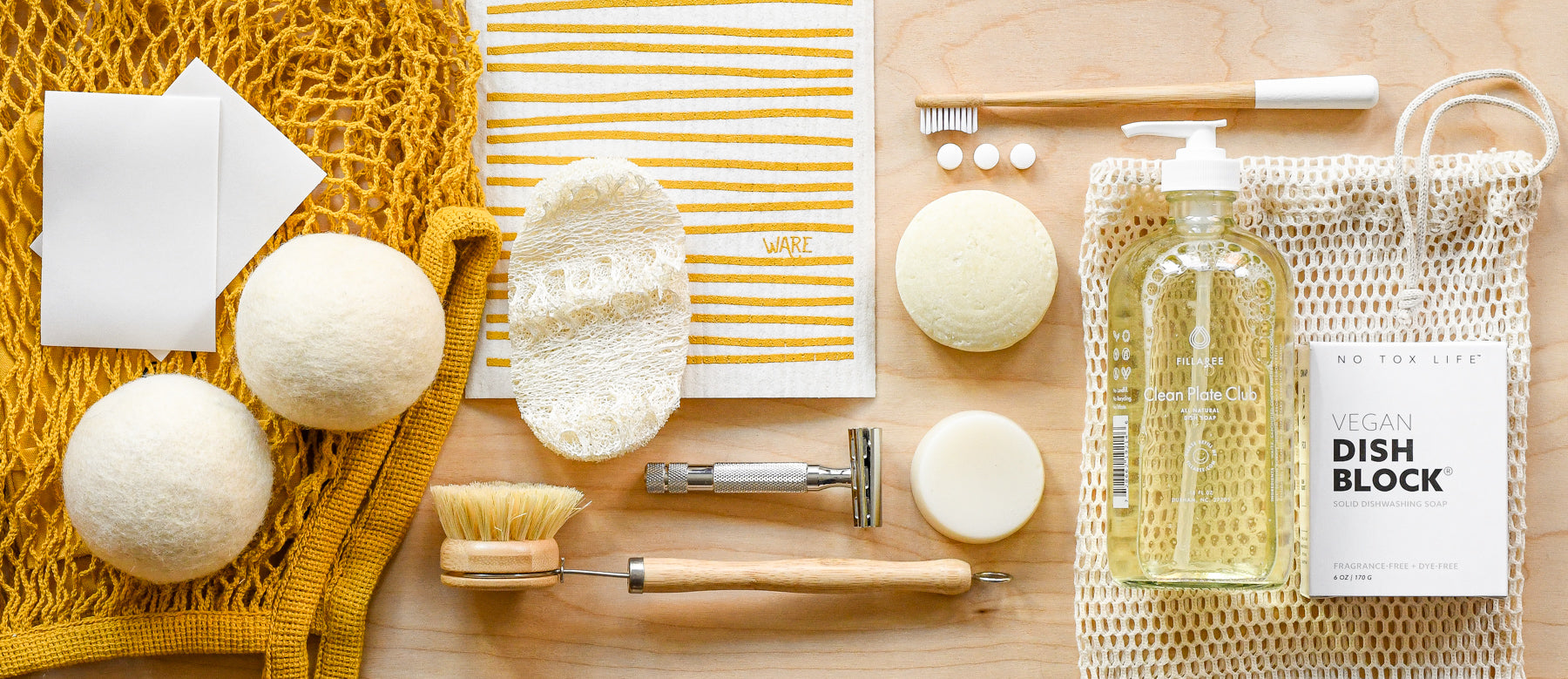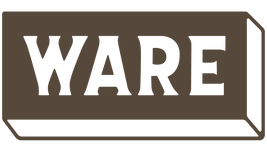
Sustainable Swaps: Where to Start Your Zero-Waste Journey
If you've stepped foot into our brick & mortar or visited our online store, you know we carry a *large* selection, ranging from items for the home to personal care to general lifestyle, and plenty in between, outside and around. And our inventory is always growing as new sustainable swaps become available (after significant R&D from our end first, of course). It's not rare for folks to come in, see our vast inventory, and become a bit overwhelmed when they realize just how much plastic has been integrated into their everyday lifestyles, particularly if they're new to the world of zero-waste.
From doing the dishes to washing your hair and drying your clothes, plastics and chemicals are marketed to consumers from every angle. Just take a look down the aisle of any general store—it's nearly impossible to avoid because we've been taught for so long to accept this as our reality.
While we're happy to help folks become more conscious of the products they use, it's also not at all our intent to overwhelm or convince people to change everything about their lifestyles. It takes time and resources, and it's certainly not an overnight venture. As Anne-Marie Bonneau of Zero-Waste Chef said best,
"We don't need a handful of people doing zero-waste perfectly. We need millions of people doing it imperfectly."
Sure, shampoo bars are great, but, if you've got a half-full container of bottled shampoo at home, we strongly encourage you to use that product up first before swapping to a more sustainable option. Because, if we're just leaving unused product behind, we're really just creating more waste both in terms of the product itself, but also in terms of the resources that have already gone into manufacturing the container you've already purchased. You could even thoroughly clean that same bottle once its contents are used up and bring it in to our Refill Station.
So, what are the swaps we see folks making toward the beginning of their zero-waste journey?
The Swaps
The Dishes
1. The Soap: Solid or liquid? Yes. The Dish Block is conveniently packaged in a recyclable paper box and replaces an entire bottle of dish soap! Cuts through grease just the same (that's a lie, it's definitely better). Another fantastic option is Clean Plate Club, a liquid dish soap. Not to mention you can bring it back and fill it in our Refill Station.
2. The Scrubber: Brushes or sponges—we've got you. The Replaceable Head Dish Brush is a great option because, as long as you're letting your brush properly dry/drain, you'll really just need to replace the heads as the bristles wear down over time. More of a sponge fan? These Loofah Sponges are a fantastic alternative to those bright blue things that send microplastics directly down the drain and into our waterways. They're completely biodegradable, and also a fantastic exfoliator in the shower (because they're sold in packs of three and we love a multi-use product!).
3. The Clean-Up: Goodbye single-use paper towels, hello Swedish Cloths and good ol'-fashioned Rags. When slightly moistened, Swedish Cloths sop up any spilled mess and leave a squeaky clean surface. Plus, they can be run through the dishwasher or put in the washing machine if they need a good clean themselves! Not into the reusable paper towel concept? Grab a rag! Need to wipe down the counters? Rag. Spilled water (or wine)? Rag.
Personal Care
1. Teeth: Your plastic toothbrush from elementary school? It still exists. When it's time to replace your current toothbrush, consider swapping it for a Bamboo Toothbrush with castor oil bristles! Have an electric toothbrush? These Bamboo Electric Toothbrush Heads are compatible with your existing Sonicare brush. And when you're done with your tube of toothpaste, switch it out for Toothpaste Tablets. We get questions about what these little guys are all the time, and they're basically just undiluted toothpaste, eliminating the need for plastic tubing. Plus, they're all-natural and contain a fluoride-alternative, hydroxyapatite, a material our saliva uses to remineralize our teeth. Neat, right?
2. The Hair: Much like toothpaste tablets are to toothpaste, Shampoo & Conditioner Bars are basically the same for your hair. Beware—they are not all made equally. We've gone through MANY to find the ones we and our customers swear by—that don't crumble upon first use, last about twice as long as a bottle would, and are salon-grade and actually work. Not into the bar hair care idea? We've got fantastic liquid Shampoo and Conditioner available bottled and in our Refill Station!
3. The Hair, pt. 2: RAZORS. You know those blades that are encased in plastic for you to hold while shaving (which also comes wrapped in even more plastic packaging)? When you're through the stash of razors your mom sent you in a care package in college, we recommend a Safety Razor—metal, nearly impossible to cut yourself with on the Size 1 blade, and no plastic in sight.
Laundry
1. The Detergent: Again with the diluted products resulting in the need for unnecessary, MASSIVE plastic jugs! Switch to Laundry Powder (made locally and available in our Refill Station, or packaged in paper online) or Laundry Detergent Sheets (no, these are not the same as dryer sheets—they're simply sheets of concentrated detergent!).
2. The Guppyfriend: Fashion is full of synthetic fabrics, and so are most of our wardrobes. While shopping with intention plays a huge step in reducing microplastics being sent to the ocean and consumed by animals (which we as a species then later consume), if we already have these synthetic fabrics, it's important to know how to properly care for them and how to lessen their impact on the environment. The Guppyfriend is a bag you throw your synthetic fabrics in during the washing cycle, where the fibers that break away from your clothing will be collected along the seam of the bag for you to collect and throw in the trash. Again, not a perfect solution to the mass production of synthetic fabrics, but it sure beats knowingly sending microplastics directly into our waterways from our weekly chore of doing laundry.
3. Dryer Balls: Here's where the dryer sheets come in. Yeah, those things full of chemicals & carcinogens marketed to us to help soften our clothes. Replace them with Dryer Balls for the same softening, while also helping to reduce your drying times with the opposing forces of the balls in the dryer drum. Double win.
Lifestyle
1. Beverages: Please stop using plastic water bottles & straws. Grab a reusable Water Bottle & a Metal Straw. It's low-hanging fruit, people. Just do it.
2. Grocery Bags: It's shocking to enter the grocery store and still see plastic bags that will be used for a matter of minutes to transport groceries from the produce section or checkout to your refrigerator. We're fans of Cotton Produce Bags and Market Totes for helping us to lug our groceries around the grocery store and the morning market alike.
3. Sandwich Bags: Okay, not just sandwiches, but bags in general. The single-use plastic bag is a baffling concept. These days, our library of Stasher Bags is full of different sizes and colors. Midday snacks, dog treats, toiletries when traveling, your phone at the beach or on the riv—these water-tight reusable bags put all those flimsy plastic bags to shame, and last MANY years and uses.
This sort-of guide is nowhere near complete, and there are an infinite amount of ways to reduce your footprint, and it certainly varies from person to person, and the resources available to those people (which is a whole other conversation). However, these are great first stepping stones to help guide you on your journey to reducing waste. Again, it doesn't happen overnight. It takes time and research, and it certainly isn't a linear process. It's okay to get that takeout food on occasion. Maybe consider saving the packaging and using it for bulk refill items next time. We live in a society where it is extraordinarily difficult to avoid plastic and other environmental pollutants entirely. But, as Anne-Marie Bonneau suggests, if we're all conscious and aware of our waste, and imperfectly making swaps where we are able, we and the planet will be far better off in the future.





Leave a comment